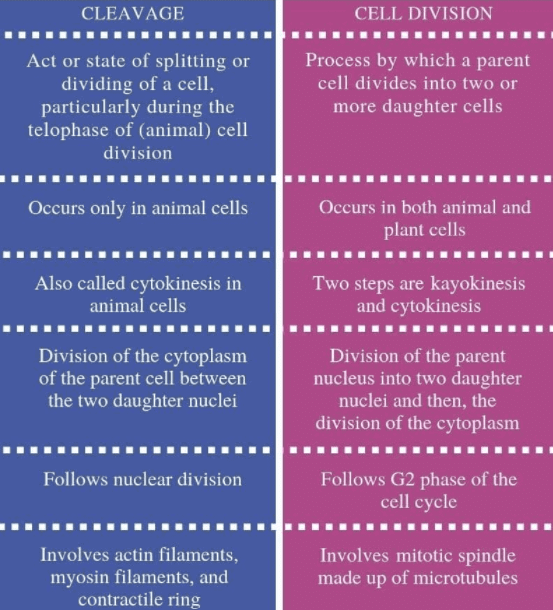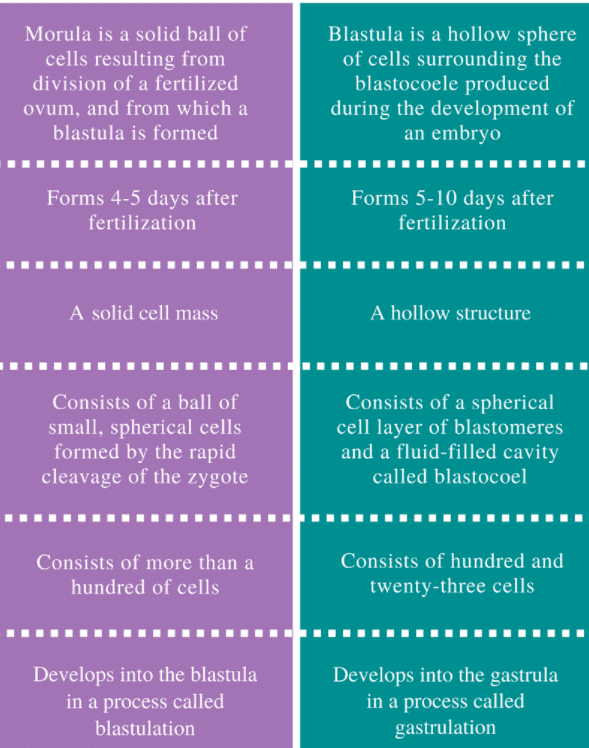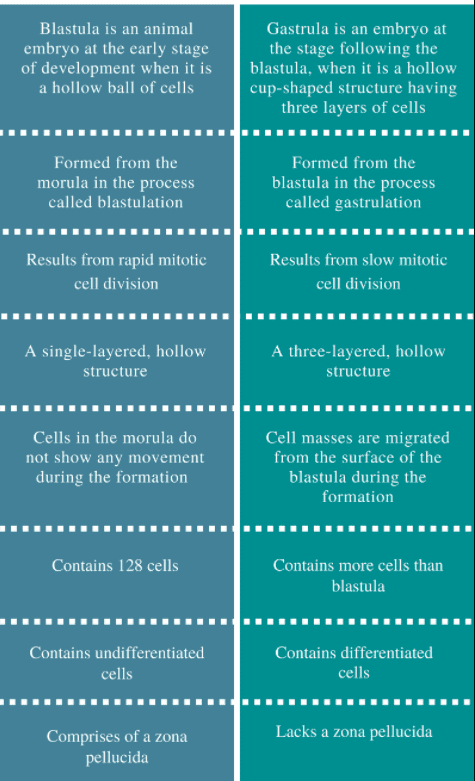Phases of Cleavage | Biology for Grade 12 PDF Download
Cleavage (Cellulation or Segmentation)
- The term 'Cleavage' was given by "Von Baer".
- In fertilized egg or activated egg, the egg undergoes repeated cell divisions which occur rapidly producing a multicellular structure without changing its size.
- All these rapid mitotic cell divisions are collectively called cleavage or segmentation.
- Due to the process of cleavage, a single-celled zygote, through successive mitotic cell divisions changes into a complex multicellular structure.
- Cells produced as a result of cleavage are termed blastomeres.
Process of Cleavage
- About thirty hours after fertilization, the newly formed zygote divides into two cells, the blastomeres, in the upper portion of the Fallopian tube.
- This is the first cleavage. The next division occurs within forty hours after fertilization. The third division occurs about three days after fertilization.
- During these early cleavages, the young embryo is slowly moving down the Fallopian tube towards the uterus.
- At the end of the fourth day, this solid mass of cells is known to reach the uterus.
- It has 8-16 blastomeres and (little mulberry) as it looks like a mulberry.
- When the blastomeres divide completely the cleavage is called holoblastic.
 Early Embryonic Development
Early Embryonic Development
Significance of Cleavage
Cleavage brings about:
(i) the distribution of the cytoplasm of the zygote, amongst the blastomeres,
(ii) increased mobility of the protoplasm, which facilitates morphogenetic movements necessary for cell differentiation, germ layer formation and the formation of tissue and organs,
(iii) the restoration of the cell size and the nucleo-cytoplasmic ratio characteristic of the species.
(iv) Unicellular zygote is converted into a multicellular embryo.
 Cleavage V/S Cell Division1. Morula -
Cleavage V/S Cell Division1. Morula -
- As a result of segmentation or cleavage activities, a unicellular zygote changes into a solid ball-like multicellular structure.
- In the later stage of cleavage, clusters of sticky, cohering, protruding (outside) blastomeres are produced, which look like mulberry.
- This stage is termed as morula stage.
- The mitotic division starts as the zygote moves through the isthmus of the oviduct called cleavage towards the uterus and forms 2, 4, 8, 16 daughter cells called blastomeres.
- The embryo with 8 to 16 blastomeres is called a morula.
2. Blastulation -
- The morula continues to divide and transform into a blastocyst.
- Blastocyst - Blastula of eutherian and metatherian mammals is called blastocyst because blastula is in the form of a cyst.
- The blastomeres in the blastocyst are arranged into an outer layer called the trophoblast and an inner group of cells attached to the trophoblast called the inner cell mass.
- The trophoblast layer then gets attached to the endometrium and the inner cell mass gets differentiated as the embryo.
- Initially, the oocyte after its release from the ovary comes into the fallopian tube where the process of fertilization is completed.
- Just after fertilization, embryonic development starts and a blastocyst is formed after cleavage and morulation.
- In human beings, the blastocyst gets attached to the uterine endometrium about four days after entering the uterus.
- At the same time, the cells of the endometrium of the implantation area separate out and adhere with embryonic cells with the help of certain enzymes secreted by the cells of the trophoblast.
- In humans, the site of implantation is generally the mid-dorsal/fundus part of the uterus.
- Implantation of blastocyst takes about 7–8 days after fertilization in humans and by the 12th day, it is completely buried in the wall of the uterus.
- The place of entry through which the embryo enters into the wall is completely closed by a fibrous and cellular plug, known as closing coagulum.
The function of the zona pellucida -
- It prevents implantation of the blastocyst at an abnormal site.
- The trophoblast has the property of being able to stick to the uterine (or other) epithelium and its cells have the capacity to eat up other cells.
Interstitial implantation– The blastocyst is buried deep inside the wall of the uterus and covered by the endometrial tissues lying under the epithelium. This type of implantation occurs in human beings. After implantation endometrium is known as decidua.
 Morula V/S Blastula
Morula V/S Blastula
3. Gastrulation -
- In the gastrula stage rate of cleavage division is slow and ultimately stops at the end of the gastrula.
- Gastrula the stage is the most important stage in embryonic development because two main events take place during the gastrula stage.
(a) Differentiation of blastomere: As a result of differentiation of blastomere; three germinal layers i.e. ectoderm, mesoderm and endoderm are formed.
- The formation of three germinal layers is the significance of the gastrula stage.
- All the preparation of differentiation of blastomere is completed in the late blastula stage.
(b) Morphogenetic Movements: During the gastrula stage blastomere performs amoeboid movement and reaches their definite place in the embryo because after the gastrulation organogenesis has to start in the embryo.
- Morphogenetic movement requires enormous energy.
- So respiratory activity of the egg increases.
Old NCERT Syllabus
Method of Gastrulation
(a) Epiboly: Movement of ectoderm forming blastomere
(b) Emboly: Movement of mesoderm and endoderm forming blastomere.
- In the same animal's new cavity is formed in the gastrula this is called gastrocoel or archenteron cavity.
- Immediately after implantation, the inner cell mass (embryo) differentiates into ectoderm endoderm and mesoderm (between the ectoderm and the endoderm).
- These three layers give rise to all tissues (organs) in adults.
- It needs to be mentioned here that the inner cell mass contains certain cells called stem cells which have the potency to give rise to all the tissues and organs.
 Blastula v/s Gastrula
Blastula v/s Gastrula
|
124 videos|210 docs|207 tests
|
FAQs on Phases of Cleavage - Biology for Grade 12
| 1. What is cleavage in cellulation or segmentation? |  |
| 2. How is cleavage different from cellulation or segmentation? |  |
| 3. What are the phases of cleavage? |  |
| 4. What is the significance of cleavage in embryonic development? |  |
| 5. How does cleavage contribute to the formation of different cell types in the embryo? |  |























